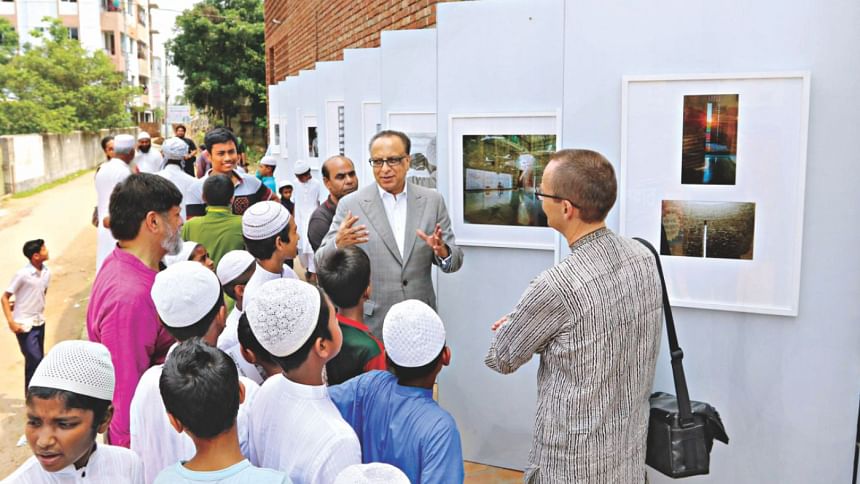More to a mosque than meets the eye

Shahidul Alam, one of Bangladesh's leading artistic voices, held a bold yet sincere exhibition yesterday on the outskirts of Dhaka that attempted to break new grounds -- literally and figuratively. The daylong photography exhibit -- “Embracing the Other” -- was held along the outer walls of the Bait Ur Rouf mosque in Fayedabad near Abdullahpur.
The mosque, recipient of the world's richest architecture prize -- the Aga Khan Award for Architecture (to architect Marina Tabassum) -- was the focal element of the exhibition. Unique in its design and for its simplicity, use of natural light and ventilation, the mosque built in the Sultanate mosque architecture is more than just a prayer space -- it can be used as a school, an informal playground and as a place for spiritual contemplation. And that is exactly what Shahdidul Alam portrays in his photos. “The Prophet Muhammad (pbuh) introduced mosques in Madinah as a multi-dimensional space -- as administrative office, shelter, educational institute and even as a nursing space. He even opened the doors to mosques to non-Muslims,” says Alam. “The concept of mosques has moved quite far away from that, and my target with this exhibition was to debunk the wave of Islamophobia in the world, and portray Islam as the religion it is -- a religion of openness and welcoming nature.”
The exhibition was initially supposed to take place inside the mosque, as agreed upon by the mosque committee and the architect, but some “pressure” prompted a slight change of plan -- to host it outside the walls.
“I came here over a long time and took photos here, and I saw that this mosque is not just for prayers; I have seen people in deep contemplation, and even resting. I have seen children play cricket outside the mosque, and even birds knitting their nests. If a ball flew in to the mosque, someone at the mosque would go and send the ball outside, without scolding the children. It gave me the feeling that this mosque is unique -- it has a life of its own, that is forgiving, open and receptive, just as the Prophet Muhammad (pbuh) had intended mosques to be,” he told The Daily Star.
Alam said he had already received calls to take this exhibition abroad and that he would like to take this exhibition to other mosques in the country as well.
In the photos, Shahidul Alam tells a complete story of the mosque in his signature style, bringing out its different elements, be it of the nature or architecture. Through portraits, architectural shots, candid and documentary-style photos, Alam almost anthropomorphises the mosque as much more than a prayer space -- an establishment with its own dimensions and dynamics far more diverse.
Din Islam, imam of the mosque, Muhammad Ibrahim, professor of the department of Islamic History and Culture at Dhaka University, and Shahidul Alam spoke at the inauguration of the exhibition. Ibrahim elaborated on the historic and cultural significance of mosques and its use as a multi-dimensional space, and cited a reference when Abyssinian (current day Ethiopia) artists came to Madinah to Prophet Muhammad's (pbuh) mosque, and wanted to exhibit their artwork in the mosques, which Prophet Muhammad's (pbuh) permitted.

Distinguished guests at the exhibition included Munir M Murali, resident diplomatic representative at Aga Khan Development Network in Bangladesh; Baroness Berridge, a British Conservative politician and member of the House of Lords (the upper house of the UK parliament); Tasmima Hossain, editor of Anannya Magazine and women's rights activist Shireen Haque. But what felt more significant than their presence was the excitement of a group of children from the adjacent madrasa, for whom it will probably be an event of subconsciously profound significance to have an interaction with some form of art, at a space familiar to them, and being included in it.

 For all latest news, follow The Daily Star's Google News channel.
For all latest news, follow The Daily Star's Google News channel. 




Comments